#TCL Industrial Holdings
Text
Flexible Pet Care Packaging Market Forecast 2024-2033
Overview and Scope
Flexible pet care packaging are defined as any container or portion of a container whose shape can easily change while filled or while being used for pet care packaging products.
Sizing and Forecast
The flexible pet care packaging market size has grown strongly in recent years. It will grow from $8.39 billion in 2023 to $9.12 billion in 2024 at a compound annual growth rate (CAGR) of 8.6%. The growth in the historic period can be attributed to consumer convenience, product differentiation, sustainability concerns, portability and lightweight packaging, resealable features, safety and tamper-resistance..

The flexible pet care packaging market size is expected to see strong growth in the next few years. It will grow to $13 billion in 2028 at a compound annual growth rate (CAGR) of 9.3%. The growth in the forecast period can be attributed to rise in premium pet products, preference for sustainable materials, focus on recyclability, hygiene and freshness preservation, interactive packaging experiences.. Major trends in the forecast period include innovative packaging designs, customization and personalization, digital printing, transparency in labeling, collaborations for innovation, online subscription services, e-commerce packaging solutions..
Segmentation & Regional Insights
The flexible pet care packaging market covered in this report is segmented –
1) By Packaging: Cans, Bags and Pouches, Folding Cartons, Tubes, Blister Packs, Plastic Bottles and Jars
2) By Material: Plastic, Paper and Paperboard, Metal, Other Packaging Materials
3) By Application: Dry Food, Wet Food, Frozen
4) By End Use: Cats, Dogs, Birds, Other End Uses
North America was the largest region in the flexible pet care packaging market in 2023. Asia-Pacific is expected to be the fastest-growing region in the flexible pet care packaging market report during the forecast period. The regions covered in the flexible pet care packaging market report are Asia-Pacific, Western Europe, Eastern Europe, North America, South America, Middle East, Africa
Major Driver Impacting Market Growth
Rising pet ownership is expected to propel the growth of the flexible pet care packaging market going forward. Pet ownership refers to any individual who has custody of or owns a dog, cat, or other domestic pet. More individuals are adopting dogs as a result of demographic shifts and increased income levels which increases the demand for pet care products and packaging. For instance, according to a 2021–2022 survey conducted by the American Pet Products Association (APPA), a US-based not-for-profit industry association that represents more than 1000 pet product manufacturers, importers of pet products, and suppliers of products for non-pet livestock, in the United States, 69 million households have dogs, compared to 45.3 million households with cats. Therefore, the rising pet ownership in flexible pet care packaging is expected to drive the growth of the flexible pet care packaging market.
Key Industry Players
Major companies operating in the flexible pet care packaging market report are Amcor PLC, Aptar Group Inc., Ardagh Group SA, Coveris Holdings SA, Crown Holdings Inc., Constantia Flexibles Group GmbH, KapStone Paper and Packaging Corporation, Mondi Group PLC, ProAmpac LLC, Sonoco Products Company, Kendall Packaging Corporation, Formell Industries Inc., Ball Corporation, Bemis Company Inc., Berry Plastics Corporation, Gateway Packaging Pty Ltd., Graphic Packaging Holding Company, Greif Inc., Printpack Inc., WestRock Company, American Packaging Corporation, Silgan Holdings Inc., Berlin Packaging LLC, Interflex Group Inc., Reynolds Group Holdings Limited, TCL Packaging Ltd., The InterFlex Group Inc., NNZ Group B.V., Huhtamaki OYJ, Winpak Ltd., Sealed Air Corporation, Smurfit Kappa Group, DS Smith PLC, Scholle Ipn Corporation, Glenroy Inc., Uflex Ltd., Wipak Group, Flextrus AB .
The flexible pet care packaging market report table of contents includes:
1. Executive Summary
2. Flexible Pet Care Packaging Market Characteristics
3. Flexible Pet Care Packaging Market Trends And Strategies
4. Flexible Pet Care Packaging Market — Macro Economic Scenario
5. Global Flexible Pet Care Packaging Market Size and Growth
.
.
.
31. Global Flexible Pet Care Packaging Market Competitive Benchmarking
32. Global Flexible Pet Care Packaging Market Competitive Dashboard
33. Key Mergers And Acquisitions In The Flexible Pet Care Packaging Market
34. Flexible Pet Care Packaging Market Future Outlook and Potential Analysis
35. Appendix
Explore the trending research reports from TBRC:
Contact Us:
The Business Research Company
Europe: +44 207 1930 708
Asia: +91 88972 63534
Americas: +1 315 623 0293
0 notes
Text
Analyzing Key Components in the Flexible Electronics Materials Market

In today’s rapidly evolving technological landscape, medical, automotive, and consumer electronics industries display a growing need for compact, lightweight, and cost-effective devices. In this regard, flexible electronics have captured the attention of these sectors, offering innovative solutions that enable the development of bendable systems with versatile shapes. Triton’s analysis signifies that the global flexible electronics market is anticipated to progress with a CAGR of 8.88% during the forecast period 2023-2030. The applications for organic photovoltaics (OPV), RFID, organic light-emitting diodes (OLED), and compacted printed electronic systems are experiencing a significant upsurge, which drives the demand for flexible electronics substrates.
Another notable trend fueling the market expansion is advancements in display technology, driven by the increasing demand for digital visuals. Expanding applications for advanced displays have influenced companies to pioneer advancements in flexible displays.
TCL, for instance, introduced the world’s first rollable extendable smartphone concept utilizing flexible AMOLED display technology. Additionally, haptic touch screens have recently been developed to provide users with tactile feedback via various textures or low electrical currents.
As the demand for compact products and innovative displays continues to rise, there is a promising landscape for the application of various flexible electronic components.
From Rigid to Resilient: Exploring the Potential of Key Flexible Components
Flexible Displays, typically made of OLED technology, are designed to withstand folding, bending, and twisting. Hence, they are increasingly used in foldable devices like smartphones, providing a compact storage option with a larger screen size for media display. As per Triton’s analysis, the flexible display category captured the highest share at $20263.22 million in 2022 in terms of components.
The initial appeal of folding displays lies in their novelty nature, which garnered significant attention for products like the Samsung Galaxy Fold and Motorola Razr. China’s Royole, for example, made advancements in flexible displays with its FlexPai Phone and even ventured into wearable applications such as flexible displays on t-shirts and hats.
Moreover, flexible consumer electronics are gaining popularity due to their unique characteristics, such as lightweight design, bendability, ruggedness, and lack of brittleness. In this regard, OLED displays, commonly found in smartphones, tablets, and TV screens, offer enhanced picture quality and energy efficiency through higher contrast and vibrant colors. The market holds promise for curved displays, allowing mobile phones to enhance user comfort. In terms of application, the consumer electronics category is likely to advance with 9.01% of CAGR over 2023-2030.
Flexible Sensors, also known as bend sensors, have gained significant attention for their exceptional properties like high stretchability, excellent biocompatibility, great conformability, and low cost. This has prompted various company initiatives, widening their applications in emerging fields like industrial IoT, healthcare, etc. For instance, Japan Display Inc developed the world’s first flexible low-temperature polysilicon thin-film transistor tactile sensor.
In recent years, wearable biosensors for health monitoring have gained considerable attention as they enable real-time health status monitoring, measuring various parameters like glucose, lactate, pH, cholesterol, pulse rate, temperature, etc. In this regard, using solution-based nanomaterials processed through printing techniques holds promise for cost-efficient manufacturing on flexible polymeric substrates. Per our analysis, the medical and healthcare category is estimated to witness the fastest growth at a CAGR of 9.23% during the 2023-2030 forecast period.
Flexible Photovoltaics is projected to emerge as the fastest-growing component between 2023 and 2030, growing at a CAGR of 9.30%. Thin film PV, a cost-effective alternative to traditional crystalline Si-based PV, offers flexibility and new design possibilities for solar cells. Flexible PV devices are highly sought-after for indoor and outdoor applications due to their ability to integrate with structures of different shapes and sizes. Furthermore, flexible PV modules possess faster payback than conventional ones. As a result, various PV materials have been developed using different deposition methods on flexible substrates.
Flexible Electronics Market: Industry 4.0 and Smart Homes to Accommodate Opportunities
With advancing technology, factories are increasingly embracing automation and connectivity, leading to the rise of Industry 4.0. This paradigm shift involves automating manufacturing processes and upgrading architectures to enhance productivity. Within the industrial platform, electronic design, development, manufacturing, assembly, and distribution hold significant importance.
Furthermore, there is a surge in the adoption of wearables, portable devices, and remotely connected devices across various sectors, such as automotive and smartphones. In this context, flexible electronic devices play a pivotal role, enabling machine-to-machine and human-to-machine connections. Moreover, they offer numerous advantages over non-flexible counterparts, including cost-effectiveness, reduced energy consumption, and lightweight construction.
Integrating physical manufacturing activities with machine learning, artificial intelligence, big data, Industry 4.0, and industrial IoT further drives the application of flexible electronic materials in industrial manufacturing. For instance, robots, sensors, and RFID tags find extensive use in tracking product movement and other operational functions.
Therefore, the proliferation of connected devices contributes heavily to the growing demand for flexible electronics in smart homes, which opens new avenues for the flexible electronics market.
FAQs:
Q1) What is the global flexible electronics market size?
In 2022, the global flexible electronics market attained $37634.72 million and is expected to garner $74779.19 million by 2030.
Q2) What are the key applications of flexible electronics?
The key applications of flexible electronics include consumer electronics, medical and healthcare, automotive, and energy sectors.
#Flexible Electronics Market#Consumer Goods & Services#Consumer Electronics#triton market research#market research reports
0 notes
Text
Tata Communications Share Price
Tata Communications Limited, positioned at the forefront of the global digital revolution, holds a pivotal role in driving enterprises towards comprehensive digital transformation. This article delves into the intricacies of Tata Communications, exploring its diverse business segments, financial performance, and the multitude of factors influencing its share price. Additionally, we will analyze both present and future share price targets associated with the company.
Business Landscape:
Tata Communications, headquartered in India, stands out as a global digital ecosystem enabler, providing a spectrum of services across various segments to meet the evolving needs of businesses worldwide.
In the Voice Solutions segment, Tata Communications facilitates international and national long-distance voice services, highlighting its commitment to seamless global communication.
The Data Services segment encompasses core and connectivity services, digital platforms, and connected services, showcasing the company's role in ensuring secure and robust data services for its clientele in an era of increasing reliance on data-driven strategies.
In the Payment Solutions segment, Tata Communications focuses on providing end-to-end services, including ATM deployment, POS enablement, hosted core banking, financial inclusion, card issuance, and related managed services, illustrating Tata Communications' comprehensive solutions tailored for the banking sector.
The Transformation Services segment involves providing telecommunication network management and support services, addressing the growing demand for efficient network management in a rapidly advancing technological landscape.
Beyond traditional services, the Real Estate segment includes lease rentals for premises given on lease, diversifying Tata Communications' portfolio. Through its subsidiary, Kaleyra, Inc., the company extends its reach by offering omnichannel integrated communication services.
These figures offer a snapshot of Tata Communications' financial trajectory, reflecting revenue variations, positive operating income growth, and generally positive net income.
Tata Communications Share Price Dynamics:
Understanding Tata Communications' share price requires insight into the factors influencing it, including the company's financial performance, industry trends, and broader economic conditions.
As of the most recent data, Tata Communications' share price mirrors the market's valuation of the company. Investors scrutinize financial indicators such as EPS, revenue growth, and profitability to make informed decisions.
Keywords such as "Tata Communications share price target 2025" indicate a keen interest in both present and future share price evaluations. Investors are not only concerned with the current share price but are also seeking projections into 2025, indicative of a long-term investment perspective.
Terms like "Tata Communications news today" and "TCL share price today" underscore the importance of real-time information. In the digital communication and technology sector, current news can significantly impact investor sentiment and share prices.
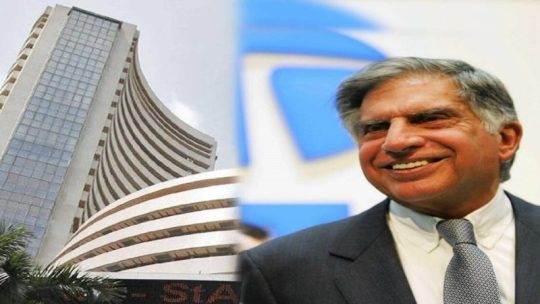
Share Price Targets: Present and Future:
Share price targets involve predicting a stock's future trajectory based on various factors. Analysts, investors, and market experts set these targets by considering the company's fundamentals, industry trends, and broader economic conditions.
As of now, Tata Communications' share price reflects market sentiment and various influencing factors. Investors should conduct thorough research or seek advice from financial experts to make well-informed decisions.
Looking forward to 2025, share price projections become speculative and analytical. Analysts employ diverse methodologies, including fundamental and technical analyses, to forecast future share prices. These projections consider the company's growth prospects, potential challenges, and the overall economic outlook.
It's essential to recognize that share price targets are informed estimates rather than guaranteed outcomes. The dynamic nature of financial markets means that actual prices may vary based on a multitude of factors influencing investor behavior.
Recent Developments and News:
Staying abreast of recent developments is vital for investors, as highlighted by the keywords "Tata Communications news today." Significant announcements, partnerships, or industry shifts can impact Tata Communications' stock performance, emphasizing the need for real-time information.
The inclusion of "Tata Play share price target" draws attention to the interconnected nature of Tata Communications with its subsidiaries and their potential influence on the overall valuation. Investors may seek to understand the impact of subsidiaries on the parent company's share price.
In Conclusion:
Tata Communications Limited emerges as a key player in the digital realm, offering a comprehensive range of services that align with evolving global business needs. The company's financial performance indicates resilience and adaptability in a dynamic market.
As investors navigate the complexities of the stock market, understanding Tata Communications' share price targets and staying informed about the latest developments becomes crucial. The year 2025 presents both challenges and opportunities on the horizon, and investors are closely monitoring Tata Communications for its potential growth.
In conclusion, Tata Communications stands at the intersection of technology, communication, and innovation, shaping the digital landscape for enterprises worldwide. As the company continues its journey, investors will be keenly observing the unfolding chapters in the Tata Communications story, guided by financial metrics, market dynamics, and the ever-evolving digital landscape.
0 notes
Text
Global High Barrier Packaging Films Market Surges with Sustainable Solutions in 2030
The packaging industry has experienced a significant breakthrough with the emergence of high barrier packaging films, incorporating a variety of materials such as polyethylene, polypropylene, polyethylene terephthalate (PET), and polyvinyl chloride. These advanced films provide enhanced barrier properties against moisture, gas, and temperature when compared to traditional packaging materials. Moreover, high barrier packaging films are renowned for preserving the quality characteristics of packaged products, including taste, texture, color, and consistency. In addition to surpassing conventional plastic or paper packaging, high barrier packaging also improves the absorption and bioavailability of nutrients in food products. Beyond the food and beverage sector, the pharmaceutical and agriculture industries are increasingly embracing high barrier packaging films for their respective products.
To Know More Request Sample of this Report@ https://www.infiniumglobalresearch.com/market-reports/sample-request/10
The high-barrier packaging films market is experiencing growth due to the rising demand for packaged food and beverages. The surge in demand for convenient food and ready-to-eat meals has led to a substantial uptick in the need for high-barrier packaging films. These films prove highly effective in maintaining the freshness and quality of food and beverages while extending their shelf life. The expansion of the pharmaceutical industry further fuels market growth, as high-barrier packaging films are extensively employed to protect drugs from moisture, oxygen, and other environmental factors. Nevertheless, fluctuating raw material prices pose a challenge to the market's expansion, introducing cost uncertainties and diminishing profit margins for manufacturers. These challenges may impede investment and innovation, limiting the industry's growth potential. However, the escalating demand for user-friendly packaging creates a lucrative avenue for the high barrier packaging films market. Consumers are increasingly seeking convenience and sustainability, propelling the adoption of innovative packaging solutions. This trend presents significant growth opportunities as companies develop barrier films that align with both consumer preferences and environmental considerations.
The Asia Pacific region holds the global high barrier packaging films market owing to its substantial consumer base. The region is expected to provide immense growth opportunities, given the easy availability of raw materials. The food and pharmaceutical industries in the region are expanding rapidly, and the healthcare sector is receiving increasing government budget allocations, which will further propel market growth. Moreover, North America is the fastest growing region in global high barrier packaging films market. The region's robust packaged food and pharmaceutical industries, coupled with the booming e-commerce industry, are driving the demand for high barrier packaging films in North America.
Enquire Here Get Customization & Check Discount for Report @ https://www.infiniumglobalresearch.com/market-reports/customization/10
Key Market Players:
Cosmo Films
Amcor plc
Sealed Air
Mondi
Glenroy, Inc.
Ampac Packaging
Cosmo Films
Berry Global Inc.
TCL Packaging
Eagle Flexible Packaging
More Insights on this report, Speak to Our Analyst @ https://www.infiniumglobalresearch.com/market-reports/enquiry/10
The report provides deep insights into demand forecasts, market trends, and micro and macro indicators. In addition, this report provides insights into the factors that are driving and restraining the growth in this market. Moreover, The IGR-Growth Matrix analysis given in the report brings an insight into the investment areas that existing or new market players can consider. The report provides insights into the market using analytical tools such as Porter's five forces analysis and DRO analysis of the high barrier packaging films market. Moreover, the study highlights current market trends and provides forecasts from 2023-2030. We also have highlighted future trends in the market that will affect the demand during the forecast period. Moreover, the competitive analysis given in each regional market brings an insight into the market share of the leading players.
About Us:
Today, the business organizations are going through transformation with competition getting fiercer and business practices becoming more aggressive. Companies that have abilities to fine tune their internal environment and amend themselves to be more competitive only survive, img/abouts have a risk of failure or being acquired. Some business organizations are vigorously working on their business strategies to make the most of the competition, while img/abouts are striving to survive in the competition and get along.
Infinium Global Research LLP is started with a single motto of being business partner of first choice. We at Infinium work on the strengths of our clients to ensure we help them consolidate their market position. We firmly believe in the fact that ‘if you are able to develop newer opportunities then you find there is no dearth of opportunities for you. With our strategic research approaches and deep dive in the market segments, we try to find out new opportunities that our clients can encash with their existing resources. Our experts with over 100 years of cumulative experience in research offer the best in the industry services to our clients to ensure that they achieve their business goals.
Contact Us:
2nd Floor, Ganadish Empire,
Rahatani Chowk, Pimple Saudagar,
Pimpri-Chinchwad, Maharashtra 411027
+91 99239 50043
0 notes
Text
Tata Capital Unlisted Share Price, IPO, and Valuation
TATA Capital, a financial powerhouse under the esteemed TATA Group, stands as a symbol of trust and commitment in the financial landscape. From providing flexible and tailored loan solutions to nurturing wealth through innovative investment avenues, TATA Capital seamlessly integrates financial expertise with a deep understanding of the evolving needs of its customers. Whether home loans, personal loans, business loans, or wealth management services, TATA Capital's diverse portfolio reflects its dedication to fostering growth and prosperity. TATA Capital Upcoming IPO is set to be launched in the ongoing FY24.
This allows investors to take the first mover advantage by investing in TATA Capital Pre IPO shares. TATA Capital Share Price is valued at ₹660 only & is available exclusively on the Planify platform. Investors can expect to gain exponential returns by investing in TATA Capital Pre IPO shares.
Before investing, Investors should consider studying the business model of TATA Capital. Through this article, investors can learn about TATA Capital’s Business Model, its Financial Performance in recent years & comparison with industry peers. A world of caution on valuation would also be presented before the investors.
TATA Capital Services can be divided into 5 sectors namely TATA Capital Financial Services Limited (TCFSL), TATA Capital Housing Finance Limited (TCHFL), TATA Cleantech. Capital Limited (TCCL), TATA Securities Limited (TSL) & TATA Capital Private Limited (TCPL). Now let’s try to understand each of these models:
TATA Capital Financial Services (TCFSL): TCFSL’s main area of expertise lies in Retail finance, SME & Commercial Finance. The products offered by TCFSL include Auto loans, Construction Equipment and Commercial Vehicle Loans, Business Loans, Consumer Durable Loans, and loans against Securities and assets.
TATA Capital Housing Finance Limited (TCHFL): TCHFL primarily offers home loans & affordable housing finance loans, loans against property & loans to developers for constructing residential & commercial premises.
TATA Cleantech. Capital Limited (TCCL): TCCL is a Joint Venture between TCL & International Finance Corporation, Washington DC, USA. TCCL is registered with RBI as an Infrastructure Finance Corporation (IFC) & it deals in providing finance & advisory services to cash-flow-based renewable energy projects.
TATA Securities Limited (TSL): TATA Securities currently operates as an AMFI registered Distributor, engaged in the business of distribution of Mutual Fund units. TATA Securities is also registered as a Depository participant with Central Depository Services (India) Limited & National Securities Depository Limited (NSDL) & is also registered with SEBI as a Research Analyst.
TATA Capital Pte. Limited, Singapore: TCPL carries out the business of proprietary investments & fund management, either on its own or through subsidiaries.
Beyond financial services, TATA Capital's commitment extends to fostering a sustainable future through initiatives that prioritize environmental and social responsibility. This holistic approach aligns with the TATA Group's ethos of making a positive impact on society while delivering excellence in every financial endeavor.
A good business model is the cornerstone of sustainable success, seamlessly aligning value creation with profitability. It identifies a clear target market, addresses customer needs effectively, and outlines a revenue strategy that stands the test of time. Investors shall also pay attention to the financials of a company. This might help investors in their decision-making & also become a bit cautious about certain ratios where the stock might be over-valued.
Let's begin by assessing TATA Capital's Market Cap in comparison to its industry counterparts. With a robust market cap of Rs. 2.34 Lakh Cr., TATA Capital outshines its closest peer, L&T Finance Holding. The company's strong financial performance is evident in its expanding Operating Profit Margin, reaching an impressive 46.01%, 53.07%, and 71.56% in FY21, FY22, and FY23, respectively. The Net Profit Ratio follows a similar upward trajectory, standing at 42.85% and 55.62% over the last two years.
Additionally, TATA Capital exhibits a positive trend in Returns on Assets (RoA), indicating efficient asset utilization with RoA figures of 1.94 and 2.48 for the corresponding years. Investors will find encouragement in the company's healthy Return on Equity (RoE), recording 15.23% and 19.01% in the same period.
Despite these commendable performances, caution is warranted, especially in considering the Price to Book Value (P/BV) and Price to Earnings (P/E) ratios. TATA Capital's P/BV ratio is notably high at 15.2, approximately 12 times that of its peers, and a staggering 14 times higher than the industry average P/E of 1.5. Similarly, the P/E ratio is reported at 78.0, nearly 4 times higher than its nearest industry peer at 20.9. The industry P/E of 21.0 underscores the perception that the stock may be currently overvalued, urging potential investors to weigh the risks carefully.
All being said & done, as the TATA Capital unlisted share price reflects the strength of investor confidence, anticipation is building for TATA Capital Upcoming IPO. The trajectory of TATA Capital unlisted shares hints at an exciting journey ahead, providing investors with a glimpse into the company's potential growth. The fact that TATA has just launched a spectacular IPO with TATA Tech. , getting listed at a premium of over 162% only solidifies investor’s interest further. Just a quick reminder for the investors as they get a chance to gain exponentially byb investing in TATA Capital Unlisted Shares, exclusively available on the Planify platform. Stay tuned for an opportunity to be part of TATA Capital's next chapter in the financial landscape.
0 notes
Text
'Christopher Nolan's Oppenheimer has been on a legendary box office run since its release on July 21, and a big factor in that is down to the movie's exceptional performance on IMAX, and in particular, the 70mm format which Nolan has been championing as both the gold standard of film and his own personal preference and recommendation for how audiences can best experience the three-hour epic about the making of the atomic bomb.
In terms of raw figures, the movie's achievements position it as the 8th highest-grossing IMAX release in history. This result also factors in the notable absence of markets such as China, Japan, South Korea, and Russia, where the film has not yet been showcased (and in some cases, may not be at all). The film's earnings from IMAX screenings alone have surged impressively to $114.2 million as of the beginning of this week. Presently, Oppenheimer holds the distinction of being the second film to surpass the $100 million mark at the IMAX box office in comparable markets.
However, Oppenheimer was also filmed in full frame IMAX 15 Perf 70mm Film, and there are only 30 theaters worldwide capable of playing the film in that format, alongside others that are capable of showing the film in standard 70mm. One such theatre which can display the film in 70mm is the TCL Chinese Theatre, the legendary cinema in the heart of Hollywood and Oppenheimer now has the distinction of being the highest-grossing film in the theatre's storied history.
On Wednesday, the film had passed the threshold and grossed a total $1.53 million since release, beating the previous record of $1.51 million which was set by Star Wars: The Force Awakens in 2015. Star Wars took 15 weeks to reach this total, while Oppenheiner took only 3 weeks. Oppenheimer has been extended at the TCL Chinese Theatre in IMAX 70mm film through the end of August. "It's been a historic run for us at the TCL Chinese with weeks of sold-out shows. We've added 6am shows for the last four weekends to satisfy audience demand," says Brett Fellman, executive with the TCL Chinese Theatres.
Why Is the Chinese Theatre So Sacred?
The Chinese Theatre, officially known as TCL Chinese Theatre, is a historic movie palace located on Hollywood Boulevard in Los Angeles, California. It has played a significant role in the history of cinema and is renowned for its iconic forecourt featuring celebrity handprints, footprints, and signatures in the concrete. The Chinese Theatre stands as a symbol of Hollywood's golden age and the entertainment industry's cultural impact.
The theatre's grand opening in 1927 featured the premiere of Cecil B. DeMille's silent film The King of Kings. The event marked the beginning of the Chinese Theatre's legacy as a venue for high-profile film premieres and events. A few weeks after the opening, actress Norma Talmadge accidentally stepped into wet cement while visiting the theatre, which was the launching point for the tradition of celebrities leaving a signature in the forecourt. In 2013, the Chinese electronics company TCL secured the naming rights for the theatre, and installed an IMAX auditorium, leading to Oppenheimer taking its place in the grand history of the iconic theatre.'
#The Chinese Theatre#Hollywood Boulevard#IMAX#Oppenheimer#The King of Kings#Cecil B. DeMille#Star Wars: The Force Awakens#Christopher Nolan
0 notes
Text
Electro-Optical/Infrared Systems Market
The global electro-optical/infrared (EO/IR) systems market size is expected to reach USD 20.36 billion by 2026, exhibiting a CAGR of 5.84% during the forecast period. The growing necessity to improve target identification, assess threats, and monitoring in different weather conditions will spur opportunities for the market during the forecast period.
The electro-optical/infrared (EO/IR) systems market is a rapidly growing sector that plays a crucial role in various industries, including defense, aerospace, security, and surveillance. EO/IR systems encompass a range of technologies that utilize both visible and infrared light to gather valuable information about the surrounding environment. These systems are widely used for target acquisition, intelligence gathering, situational awareness, and monitoring applications.
The Report Lists the Main Companies in the EOIR Systems Market:
Lockheed Martin Corporation (The US)
Raytheon Company (The US)
Leonardo S.p.A. (Italy)
Elbit Systems Ltd. (Israel)
L-3Harris Technologies Inc. (The US)
BAE Systems PLC. (The UK)
Thales Group (France)
Northrop Grumman Corporation (The US)
General Dynamics (The US)
UTC Aerospace (The US)
Rheinmetall AG (Gernamy)
Saab Group (Sweden)
Browse Summary Of This Research Report:
Competitive Landscape:
Contract Bagged by Elbit Systems to Accelerate Market Potential
Elbit Systems Ltd., an Israel-based international defense electronics company announced that its subsidiary, Elbit Systems of America LLC received a contract by Raytheon Company, a manufacturer and leader in weapons and military electronics for the U.S. defense, to deliver the Two-Color Laser System (TCLS) for the Multi-Spectral Targeting System. The agreement between Elbit Systems of America LLC and Raytheon Company will promote the electro-optical/infrared (EO/IR) systems market revenue during the forecast owing to the Two-Color Laser System (TCLS) capabilities in airborne missions. For instance, TCLS is used in multiple military airborne platforms, including the next-generation targeting systems onboard unmanned aerial vehicles. Furthermore, President and CEO of Elbit Systems of America, Raanan Horowitz, said in a statement, “The Two-Color Laser System provides increased targeting accuracy and flexibility, minimizing the potential for collateral damage. These attributes are key to U.S. warfighters who depend on these systems for a successful mission.”
Nonetheless, the growing adoption of advanced sensors integrated systems for military applications will drive the electro-optical/infrared (EO/IR) systems market share in the foreseeable. The rising demand for unmanned vehicles for detection and surveillance will perpetually support the growth of market.
Regional Analysis:
The electro-optical/infrared (EO/IR) systems market exhibits regional variations based on factors such as defense budgets, geopolitical dynamics, technological capabilities, and market demand. Here's an overview of the regional analysis for the EO/IR systems market:
North America:
North America dominates the EO/IR systems market, primarily driven by the significant defense expenditure in the United States. The region has a strong presence of major defense contractors and technology companies, fostering innovation and technological advancements in EO/IR systems. The U.S. Department of Defense's focus on enhancing intelligence, surveillance, and reconnaissance capabilities contributes to the growth of the market in this region. Additionally, North America has a robust demand for EO/IR systems in homeland security, border surveillance, and law enforcement applications.
Europe:
Europe holds a significant share in the EO/IR systems market, with countries like the United Kingdom, France, Germany, and Italy driving growth. The European defense sector invests in modernizing its armed forces, which includes upgrading surveillance and reconnaissance capabilities. The region also witnesses demand for EO/IR systems in border security, counterterrorism operations, and maritime surveillance. Collaboration between European countries, such as joint defense projects and technology sharing, further contributes to the growth of the EO/IR systems market in Europe.
Asia Pacific:
The Asia Pacific region exhibits substantial growth potential in the EO/IR systems market. Countries like China, India, and Japan are significantly investing in defense modernization and strengthening their military capabilities. The rising security concerns, territorial disputes, and the need for advanced surveillance technologies drive the demand for EO/IR systems in the region. Additionally, the Asia Pacific region has a growing market for commercial applications of EO/IR systems, including industrial inspection, environmental monitoring, and transportation security.
0 notes
Text
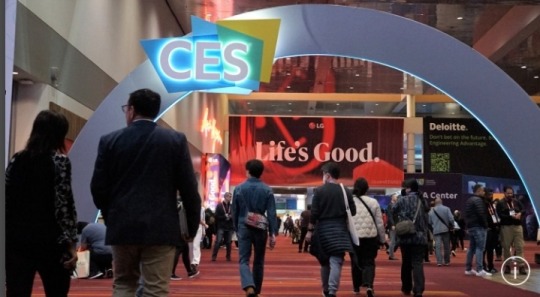
Int'l companies confident in China's innovation vitality
At the 2023 CES, Chinese companies impressed global exhibitors with innovative products and solutions, illustrating their emphasis on R&D investment and technology upgrades.
* "A lot of things happening in the tech world are starting in China and then are being extended to the world," said Oliver Zipse, chairman of the Board of Management of BMW AG.
LOS ANGELES, -- At the recently concluded 2023 Consumer Electronics Show (CES) in Las Vegas, many multinational companies showed great interest in China's innovative products and solutions and expressed optimism about China's innovation vitality.
The world's premier tech show, which concluded over the weekend with more than 3,200 exhibitors from over 170 countries and regions, drew hundreds of Chinese companies, including well-known brands like TCL, Lenovo and Hisense, as well as startups.
Oliver Zipse, chairman of the Board of Management of BMW AG, said the German auto giant would continue to deepen cooperation with its Chinese partners due to China's market and strong innovation capability.
In an interview with Xinhua and several other Chinese news outlets during the CES, Zipse said BMW is motivated to cooperate with its Chinese partners for two reasons. One is the market, as China has already been the largest market for BMW; the other is innovation since BMW's development strategy could only be realized with inspiration and innovation from China.
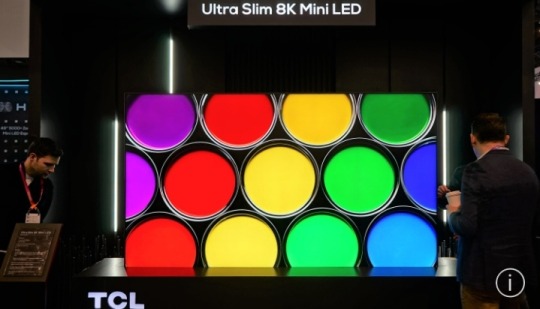
"A lot of things happening in the tech world are starting in China and then are being extended to the world," Zipse said, citing BMW's i7 Series, the latest electric luxury sedan launched in China in December, as the best example.
"The future of the BMW Group is very clear: digital, electric and circular. The future of the BMW Group also lies in the growth and the further development of our footprint in China. Because China is the frontrunner in all three strategic areas," he said. "I'm glad to see our strategic directions perfectly match the national policies of China."
More and more multinationals consider China one of the important production bases, sales markets and research and development (R&D) centers. According to Zipse, BMW has established the largest R&D and innovation team outside of Germany, with centers in Beijing, Shanghai, Shenyang, and Nanjing. Currently, BMW has about 3,200 employees in China that engaged in innovation-related work involving R&D, digitalization, electrification and other fields.
Jim Misener, senior director of product management for U.S. tech giant Qualcomm Technologies, also expressed his optimism about China's electric car innovation.
Misener said that China is leading the world in C-V2X (cellular vehicle-to-everything) technology development, mainly due to its government support and mature policies. "We always pointed to China when we talk to U.S. policymakers."
The C-V2X technology holds the potential to deliver transformational benefits in road safety and enhance environmental sustainability.
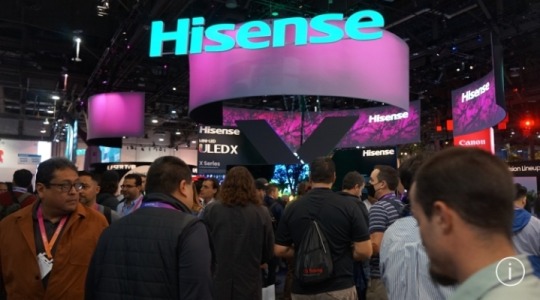
At the 2023 CES, Chinese companies impressed global exhibitors with innovative products and solutions, illustrating their emphasis on R&D investment and technology upgrades.
IRest, a massage equipment company based in China's southeastern Zhejiang Province, showcased different types of massage chairs, attracting a long line of visitors.
Liu Shijian, iRest's manager of the exhibition department, told Xinhua the company is committed to technology innovation and has introduced artificial intelligence in its 3D intelligent manipulator, which is the core technology of its massage chairs and can better assist programming and offer a personalized experience for consumers.
China's machinery and electronics industry has strong resilience, relatively complete industry chains and efficient supply chains, Shi Yonghong, vice president of the China Chamber of Commerce for Import and Export of Machinery and Electronic Products, told Xinhua. Shi added that China has been the world's largest exporter of mechanical and electrical products since 2009.
0 notes
Text
Global Flexible Packaging Market to Exhibit 4.66% CAGR by 2028
Triton Market Research presents the Global Flexible Packaging Market segmented by Raw Material (Paper, Bioplastic, Aluminum, Plastic), Application (Food & Beverage, Pharmaceuticals, Cosmetics, Others), Type (Stand-Up Pouches, Flat Pouches, Rollstock, Gusseted Bags, Wicketed Bags, Wraps), Printing Technology (Flexography, Rotogravure, Digital Printing, Others), and Geography (North America, Latin America, Europe, Asia-Pacific, and Middle East and Africa).
It further discusses the Market Summary, Industry Outlook, Impact of COVID-19, Key Insights, Porter’s Five Forces Model, Market Attractiveness Index, Vendor Scorecard, Industry Components, Key Market Strategies, Drivers, Challenges, Opportunities, Competitive Landscape, Research Methodology & Scope, Global Market Size, Forecasts & Analysis (2022-2028).
Triton Market Research’s report states that the global market for flexible packaging will expand with a 4.66% of CAGR during the forecasted period of 2022 to 2028. In terms of volume, the market is expected to progress at a CAGR of 4.01% by 2028.
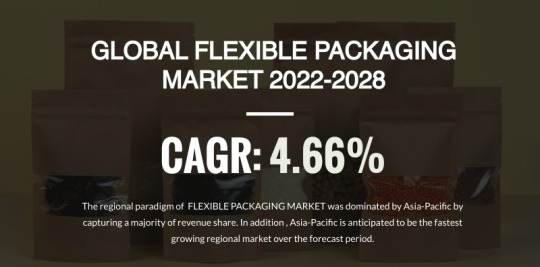
Request free sample:
https://www.tritonmarketresearch.com/reports/flexible-packaging-market#request-free-sample
Flexible packaging is the least-expensive material that comes with great durability and ensures product protection. These are an ideal solution for businesses looking for eco-friendly and customized packages that suit the product, brand, and other needs. Moreover, the shift to a green environment has influenced industries to adopt convenient and environment-friendly packaging. Besides, the rising trend of portable products such as food, beverages, pharmaceuticals, etc., has significantly boosted the demand for flexible packaging. The growing urbanization has also increased consumers’ focus on convenience in packaging, allowing manufacturers to provide innovation in packaging options. Hence, these factors are driving the market’s growth.
However, the cost of operations has constantly increased over the years. The materials account for 60% of the total expenses, followed by labor, manufacturing, and marketing costs. Therefore, manufacturers are increasing product costs to overcome the price rise of materials, especially aluminum, plastic, and resin. Such an increase in operational costs is restraining the growth of the flexible packaging market.
The Asia-Pacific holds the largest market for flexible packaging and is expected to bolster over the forthcoming years. The upsurge in the market is attributed to the rising packaged food market, growing plastic production, and private investments in flexible packaging. Moreover, due to the availability of low-cost labor and increasing domestic demand, the regional manufacturers are focusing on investments, expansions, acquisitions, and new product launches to expand their market share. Thus, these developments are expected to augment the growth of the flexible packaging market.
The key companies profiled in the flexible packaging market are Bryce Corporation, TCL Packaging, Takigawa Corporation, KM Packaging Services Ltd, Okura Industrial, American Packaging Corporation, Coveris Management GmbH, Solvay SA, Sealed Air Corporation, Kohjin Film & Chemicals Co Ltd, Mitsui Bussan Packaging Co Ltd, Bischof + Klein SE & Co KG, EPAC, Rengo Co Ltd, Michelman Japan LLC, Flair Flexible Packaging Corporation, Dai Nippon Printing Co Ltd, Hosokawa Yoko Co Ltd, Amerplast, Amcor Ltd, Mondi Group, Korpack Corporation, Asahi Kasei, and Handoo Package Co Ltd.
The market shows a high degree of competition due to a large number of manufacturers providing product differentiation. Such manufacturers introduce application-specific products along with technological innovation in product design and raw materials, thus increasing the competitive rivalry.
Contact Us:
Phone: +44 7441 911839
#Flexible Packaging Market#Chemicals and Materials#Plastic Industry#market research report#market research reports#triton market research
0 notes
Text
Does the LED display industry really need 8K resolution?
As an important reference factor of LED display, high resolution determines whether the display is HD or SD.
Looking at the current LED display industry, under the background of industrial innovation, structural upgrading and scientific and technological revolution, the display technology has experienced several innovations and changes. LCD has replaced the CRT era and turned to LED as the important development direction of the industry focus. Digitization, networking and intelligence have been deeply developed and applied. In terms of consumption, people's endless pursuit of beauty, truth, details and what you want is also an important driving force for the development of the display industry. Do you know how much it costs to rent the led stage screen?
"In the process of previous display technology progress, 8K UHD is the most suitable for people's pursuit of real world visual experience, and the UHD display represented by 8K is a new round of major technological change after digitalization, intelligence and high-definition," said Hao Yabin, secretary-general of China Electronic Video Industry Association.
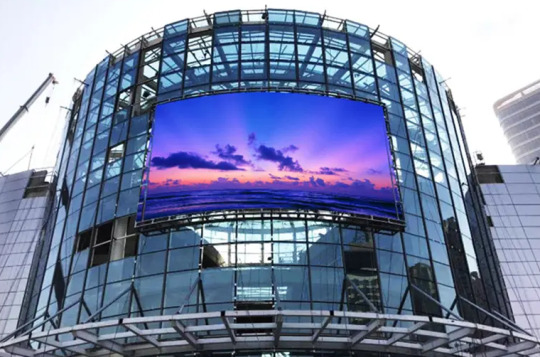
What can 8K bring?
As a new ecology, 8K is generally recognized by the industry as "larger and larger", "higher and higher resolution", "more and more clear display", etc. Wang Cheng, CEO of TCL Industrial Holding Co., Ltd., also said that the general trend of the display industry is to combine higher resolution and larger size to bring better experience to users, while driving the whole industry and even the whole society forward. "In 2013, 4K began to enter the industry, and gradually entered the family, and the TV size also reached 40 inches; in 2019, it is expected that the Chinese market display size will reach 51 inches, and 8K will gradually enter the family, and the overall size will further expand in the next five years. In this process, 8K will bring us a rapid increase in market penetration. It is believed that by 2025, the penetration of 8K products will reach 59%."
In addition to the size, 8K will also promote the upgrading of the display industry. "Including the display panel, the resolution of 8K is 4 times that of 4K and 16 times that of 2K. It will gradually turn 120Hz into the standard configuration of the product, including the transmission channel. At this time, 5G will also bring us new opportunities," said Wang Cheng, "This also includes the production of content, including artificial intelligence, 8K and many other new technologies, which will further enrich 8K content under the content production of multiple media such as film and television companies, thus forming a more complete industrial chain from content to the whole machine."

What is lacking in 8K?
As mentioned above, 8K's technology is not just coming alone. It brings a wave of new technology integration changes, bringing people more opportunities to move towards the era of full scene intelligence. So, what is lacking in 8K technology that can bring many possibilities at this stage?
"At present, 8K still faces many problems. The first is the problem of standards." Zuo Bo, general manager of the product center of TCL Industrial Holding Co., Ltd., mentioned that there is no complete 8K standard in the industry at present, so there is no complete set of standards for display, image quality processing, or content encoding, decoding, transmission and other channels. "So we see that there are a lot of products that may need to connect several HDR to display a complete 8K image, and even some products, even if connected, may not be able to achieve a real 8K display effect, but only a part of it." Zuo Bo hopes to promote the establishment of the entire industry standard of 8K through relevant industry associations and other organizations, and jointly pass the industry standards and specifications, To provide consumers with a product and service that can enjoy truly high-quality 8K images.

In addition to the urgent need to unify standards, the challenges faced by 8K also require attention to user experience. Liu Qian, Dean of the Digital Media School of Beijing Film Academy, mentioned that manufacturers are really pursuing perfection and limit in terms of product quality and precision, and the direction is really good. "But I think, should we pay more attention to user experience?" Because 8K is presented to the terminal by people. As the pixels get higher and smaller, the problem is that the best viewing distance is getting closer and closer. "Are we going to add pixels all the time now? I think it is enough for pixels to reach a certain limit, not to say that the smaller the better. Integrated circuits are not for people to see, but functional. Our display is ultimately to have user experience, so your 8K product design should be consistent with the viewing distance, and should be combined with the user's actual experience to promote innovation."
In addition, when referring to 8K, Liu Shuqing, chairman of Lerong Group, talked about the lack of content. "In 8K, the industry is generally faced with the reality that film sources are relatively scarce". In the face of new challenges in the field of content production, talent training has become an urgent matter. The action plan proposes to combine training and introduction, strengthen the construction of the talent team in the ultra-high definition video industry, and cultivate a number of high-end, composite leading talents. We will encourage industry university research cooperation, support colleges and universities to strengthen the construction of disciplines related to ultra-high definition video, and guide vocational schools to cultivate skilled talents urgently needed for industrial development. In this regard, Hao Yabin said that the China Electronic Video Industry Association and Beijing Film Academy jointly built an 8K digital content laboratory last April, which is an innovative attempt based on the consideration of training practical talents for the industry and enriching the industrial content framework.

Thank you for watching. I hope we can solve your problems. Sostron is a professional LED display manufacturer. We provide all kinds of displays, display leasing and display solutions around the world. If you want to know:In this way, we can comprehensively distinguish the quality of LED display! Please click read.
0 notes
Text
Flexible Screens market In-Depth Analysis, Growth Strategies and Comprehensive Forecast to 2022 - 2032
The Global Flexible Screens Market was valued at US$ 1.9 Bn in 2021 and is expected to reach US$ 189.5 Bn by 2032, finds Future Market Insights (FMI) in a recent market survey. A new market research report by Future Market Insights on the flexible screens market includes global industry analysis 2019–2021 and an opportunity assessment 2022–2032. As per the findings of the report, AMOLED-based flexible screens will remain pivotal for the market as the bulk of revenue will be generated through this category. It is projected that AMOLED-based flexible screens will produce over US$ 150 Bn revenue during the forecast period.
6’’ – 20’’ Screen Size Flexible Display to Continue being Growth Axis for Flexible Screen Revenue
Flexible screens of size 6’’ – 20’’ are used in smartphones, tablets, and laptops, which together account for more than 99% of all flexible screen purchases. Most other types of panel dimensions are the least likely not to gain more than 1 percent during the analyzed period, as they’re applied in electronic items such as smartwatches and wearables, TVs, and e-readers. Television manufacturing is now direct and generally high-priced, whereas e-readers still remain to be commercialized.
Get a Sample Copy of Report@https://www.futuremarketinsights.com/reports/sample/rep-gb-14728
China to Command the Larger Proportion of Flexible Screen Supply Chain throughout the Analysis Period
Also being considered the world factory, China commands most of the revenue generated in the flexible screen supply chain. While six of the top 10 flexible screen manufacturers are based in China, it also boasts manufacturing of more than 90% of the flexible screen devices developed worldwide. Owing to the high consumption of flexible devices and close proximity to the flexible screen production base, China is expected to account for US$ 1.86 Bn in revenue by 2032.
Flexible Screens Market: Competition Insights
Currently, flexible screen manufacturers are largely aiming at setting up manufacturing facilities, winning orders, and showcasing technology at exhibitions. The key companies operating in the flexible screen market include Samsung Display Co. Ltd., BOE Technology Group Co. Ltd., LG Display Co. Ltd., Visionox Technology, Inc., AU Optronics Corp., Tianma Microelectronics Co. Ltd., Shenzhen Royole Technologies Co. Ltd., E Ink Holdings Inc., HannStar Display Corporation, Everdisplay Optronics (Shanghai) Co. Ltd., Iljin Display Co. Ltd., Shenzhen RADIANT Technology Co. Ltd., and Osel Technology Pvt. Ltd.
Get In Touch With Our Team For 20% Flat Discount, Request Customization @
https://www.futuremarketinsights.com/customization-available/rep-gb-14728
The key recent developments of flexible screens manufacturers are as follows:
In April 2022, BOE announced that it will expand production lines in Western China. The production line would be fully operational by the end of 2022. The third production line in central China is for testing production. Companies nearly shipped 60 million OLED panels which are making it 2nd largest OLED manufacturer and securing 17% of the global market share. The company planned to ship 100 million OLED panel units by the end of 2022.
In May 2021, Samsung Display unveiled its latest OLED innovations at the SID Display Week trade show. It showed the way forward with its innovative offerings, such as Slidable, S-Foldable, and under panel cameras. Samsung Display unveiled its next-generation OLED technologies to the world’s biggest exhibit of displays, affirming its leadership within the industry. It opened a virtual exhibition booth to introduce its displays to potential customers.
In Jan 2021, CES 2021 showcased new products from TCL CSOT, which include a 17-inch OLED scroll print display that is 0.18 millimeters thin and a 6.7-inch AMOLED rollable display. TCL CSOT is a parent company of TCL Technology and a company that specializes in next-generation display technology. The 17-inch printed OLED scroll display for flexible, free-form displays is only 0.18 millimeters thin, a significant breakthrough for this kind of technology. It is highly scrollable and portable, and easily fits anywhere like a scrolling picture.
Report Link@ https://www.futuremarketinsights.com/reports/flexible-screens-market
0 notes
Text
TCL Holds A Grand Media Launch for Its Newest Innovations
TCL Holds A Grand Media Launch for Its Newest Innovations
Mr. Loyal Cheng, TCL Philippines CEO
TCL Electronics, one of the dominant players in the global TV industry and a leading consumer electronics, held its grand media launch introducing its new C series 98-inch TV and its new split-type air conditioner FreshIN series.
“Still moving forward with TCL’s mission of providing customers with world-class and innovative technologies that focus on giving a…
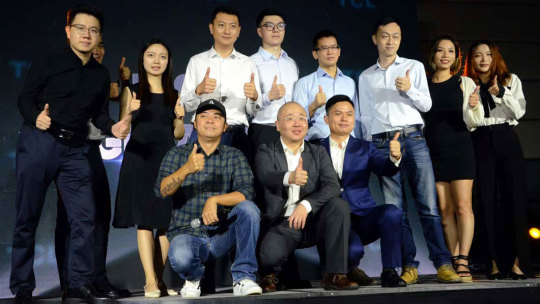
View On WordPress
0 notes
Text
TCL Channel brings in GTR24H Channel to TV content
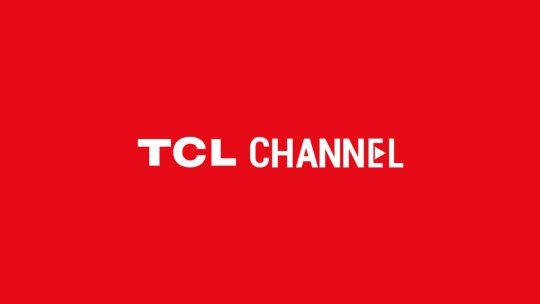
TCL Channel brings in GTR24H Channel to TV content.
TCL Channel is so far the largest digital media platform for GTR24H. Their Google Play app has more than five million downloads. TCL Channel is the digital media arm of TCL Technology Group Corporation, a Guangdong Province-based electronics manufacturer in China. Consumer goods like televisions, mobile phones, air conditioners, washing machines, refrigerators, and small electrical appliances are among the products it designs, develops, produces, and sells. It ranked as the 25th-largest maker of consumer electronics in the world in 2010. By 2019, it has overtaken Sony as the second-largest television maker by market share. TCL Corporation changed its name to TCL Technology on February 7, 2020.
TCL is made up of five publicly traded companies: TCL Technology, which is listed on the Shenzhen Stock Exchange (SZSE: 000100), TCL Electronics Holdings, Ltd. (SEHK: 1070), TCL Communication Technology Holdings, Ltd. (previously listed under the SEHK: 2618; delisted in 2016), China Display Optoelectronics Technology Holdings Ltd. (SEHK: 334), and Tonly Electronics Holdings Ltd. (SEHK: 1249).
The organizational design of TCL Technology is centred on three major sectors: semiconductor display, semiconductor and semiconductor photovoltaic, industrial finance and capital.
“TCL customers expect the best when it comes to home entertainment. With this partnership, we are excited to enhance their offerings by vastly expanding the content available to their audiences.”
-Russell Foy, CEO of Fast Channels TV
Sources:
https://www.fastchannels.tv/news/fast-channels-tv-content-lands-on-tcl-channel
https://www.digitaltvnews.net/?p=38298
https://advanced-television.com/2022/06/01/fast-channels-tv-content-lands-on-tcl-channel/
- Peter Munkholm
Read the full article
0 notes
Text
Mini LED Market By 2028 Top Winning Strategies, COVID-19 Impacting Factors, Business Strategies

Mini-LED displays are the newest trend in the TV industry trying to make their footmark among many others. And the most talked-about factor about them is that their reasonably price. This new technology offers deeper blacks and enhanced contrasts. Let’s quickly get through and understand what this new technology is all about.
What Is Mini-LED?
Mini-LED is a novel display technology that assures deeper blacks and enhanced contrast ratios as compared to LCD panels that use traditional LEDs (light-emitting diodes). The name itself implies that mini-LEDs are much smaller than normal LEDs.
Usually, diodes that are lesser than 0.2 mm are classified as mini-LEDs. These diodes are used to light a normal LCD panel in the same way as it does in a traditional LED-based TV. The major difference among them is that many mini-LEDs are installed in this type as compared to old-fashioned TVs.
Even though mini-LED technology cannot perfectly compete with the image quality of a micro-LED or OLED display, they are considerably affordable to manufacture. The bigger the panel, the more are the savings.
Click Here! To download an Comprehensive PDF Sample of Mini LED Market@ https://www.researchdive.com/download-sample/178
Advantages of mini LED:
Improved contrast ratio
Enhanced brightness
Deeper blacks
Uses inorganic Gallium nitride (GaN), won’t degrade over time like OLED
Power-efficient
Less prone to burn-in than OLED
What’s the Difference between Mini-LED and Micro-LED?
Compared to mini-LEDs, micro-LEDs are smaller in size. In a Micro-LED based display, every Micro-LED is fitted in a single pixel. Samsung, has avoided using Mini-LED and instead opted to use Micro-LED. It has used three minute LEDs for each pixel in its latest Micro-LED displays. Hence, every pixel can be switched on or off separately and emit a distinct color to the pixels besides it.
Eventually, this offers the paradigm with regards to color control and contrast ratio. The downside here is that micro-LED displays are still very costly to manufacture. 25 million micro-LEDs is required for a 4K micro-LED TV, and the process of its manufacturing is also complex and costly. This technology isn’t so far worthwhile due to the expenses incurred in its manufacturing.
Speak with an Analyst or Schedule a Call@ https://www.researchdive.com/connect-to-analyst/178
Which TV brands are onboard?
At present, TCL is the only TV Company involved in developing Mini-LEDs. This was the first one to enter into the Mini-LED market last year with two Mini-LED models making up its 8-Series. The 8-Series Mini-LED TVs integrate LCD technology and Quantum Dot, combining 25,000 LEDs right into the glass substrate of the panel.
In January 2020, at CES, TCL was strong enough to hold onto the Mini-LED technology. It boasted its first ever 8K Mini-LED TV – also part of its flagship 8-Series – and declared that a more advance version of Mini-LED model with reasonably less price is expected to launch as part of the 6-Series range by the end of 2020.
The Mini-LED technology is still in research & development phase and hence, it is difficult to express how it will be priced compared to OLED. Some TV manufacturers are expected to skip this technology altogether. However, there is no doubt that Mini-LEDs would provide a competitive substitute to OLED, by taking in some of its features and cutting the cost involved with its large panels. As each pixel does not generate its light in Mini LEDs, the sharp contrast and deep blacks are not comparable with OLED. But they are still significantly upgraded over the traditional LEDs. For bigger panels, you can literally save thousands of dollars by choosing mini-LEDs.
The Future can be bright as well as gloomy
Mini-LED is among many display technologies which are making up into the display market. Currently, there are still some technical issues in the development of Mini LEDs. However, as Micro LED technology is not completely developed until now, and as the OLED technology is massively saturated in the display market, Mini LED technology is expected to be the key to next-generation displays.
Request (Avail 10%OFF) On-demand Customization of Mini LED Market@ https://www.researchdive.com/request-for-customization/178
In the end, there are a few things you should pay attention to when purchasing a TV, but do not go off track and miss the important points: your budget and looked-for panel size.
#light emitting diode#electronics and semiconductor#electronics#consumer electronics#Mini LED Market#semiconductor#mobile phones#Mini LED#Laptops#Televisions#Automotive
0 notes
Text
bigger, faster, more beautiful!
bigger, faster, more beautiful!
A look back at the Chinese manufacturer which, in 2022, is continuing its transformation in Europe. From a TV specialist, TCL is now a generalist company with a presence in many sectors of the technical goods market (small and large household appliances, air conditioning, mobility). And like its positioning in China, it plans to expand to other product categories in the coming months. Of course,…
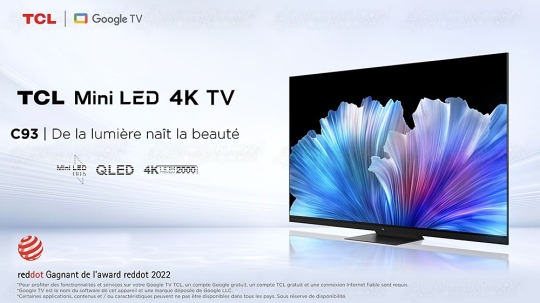
View On WordPress
0 notes
Text
plus grand, plus rapide, plus beau !
plus grand, plus rapide, plus beau !
Retour au constructeur chinois qui, en 2022, continuera de le faire en Europe. Spécialiste de la télévision, TCL est aujourd’hui une entreprise généraliste présente dans de nombreux secteurs du marché des biens techniques (petite et grande électronique, climatisation, mobilité). Et pour asseoir sa position en Chine, il compte s’étendre à d’autres catégories de produits dans les mois à venir. Bien…
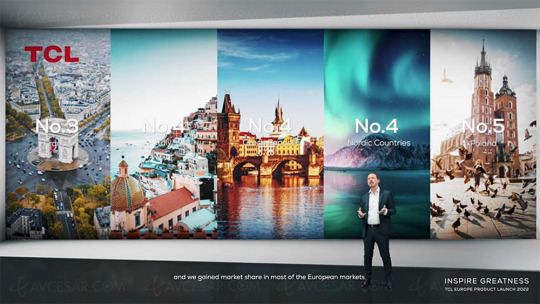
View On WordPress
0 notes